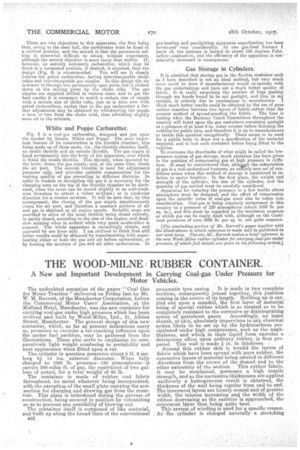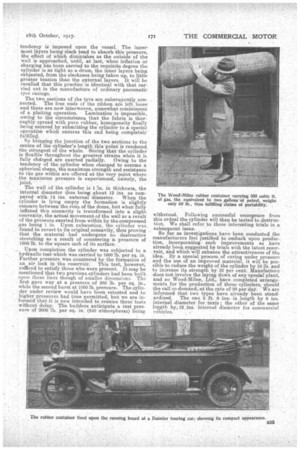THE WOOD-MILNE , RUBBER CONTAINER.
Page 16

Page 17

If you've noticed an error in this article please click here to report it so we can fix it.
A New and Important Development in Carrying Coal-gas Under Pressure for Motor Vehicles. ,
The undoubted sensation of the paper " Coal Gas for Motor Traction" delivered on Friday last by Mr. W. M. Barrett, of the Manchester Corporation, before the Commercial Motor Users' Association, at the Midland Hotel, Manchester, was the new container for carrying coal-gas under high pressure which has been evolved and built by Wood-lIfilne, Ltd., 21, Albion Street, Manchester. The general design of this new container, which, so far as present indications carry us, promises to exercise a far-reaching influence upon the motor fuel problem, may be gathered from the illustrations. These also serve to emphasize its comparatively light weight conducing to portability and neat appearance when fitted upon a car. The cylinder in question measures about 5 ft, 6 ins. long by 14 ins, external diameter. When fully charged to 1800 lb. pressure-120 atmospheres—it carries 500 cubic ft. of gas, the equivalent of two gallons of petrol, for a total weightof 60 lb.
The container is made of rubber and fabric throughout, no metal whatever being incorporated, with the exception of the small plate carrying the connection for charging and drawing gas from the reservoir. This plate is introduced during the process of construction, being secured in position by vulcanizing so as to prevent any possibility of blowing out. The container itself is composed of like material, and built up along the broad lines of the conventional B52
pneumatic tyre casing. It is made in two complete sections, subsequently joined together, this junction coming in the centre of its length. Building up is carried out upon a mandril, the first layer of material being of special rubber which is so treated as to be completely resistant to the corrosive or disintegrating action of petroleum gases. Accordingly, an inner sheath, or skin, absolutely impervious to any chemical action likely to be set up by the hydrocarbons precipitatecl'under high compression, such as the naphthalenes, and which in their liquid form exercise a deleterious effect upon ordinary .rubber, is first prepared. This wall is made j in. in thickness. Around this rubber skin is wound the layers offabric which have been spread with pure rubber, the successive layers of material being carried in different directions from the crown of the domed end to the other extremity of the section. This rubber fabric, it may be mentioned, possesses a high tensile strength, and as the successive thicknesses are applied uniformly a homogeneous result is obtained, the thickness of the wall being regular from end to end. The innermost layers are loosely wound and of greater width, the tension increasing a,acl the width of the ribbon decreasing as the exterior is approached, the outermost layer thus being quite taut.
This system of winding is used for a specific reason. As the cylinder is charged naturally a stretching tendency ig imposed upon the vessel. The innermost layers being slack tend to absorb this pressure, the effect of which diminishes as the outside of the wall is approached, until, at last, when inflation or charging has been carried to the requisite degree the cylinder is as tight as a drum, the inner layers being subjected, from the slackness being taken up, to little greater tension than the external layers. It will be recalled that this practice is identical with that car-: ried out in the manufacture of ordinary pneumatic tyre casings.
The two sections of the tyre are subsequently connected. The free ends of the ribbon are left loose and these are now interwoven, somewhat reminiscent of a plaiting operation. Lamination is impossible, owing to the circumstance that the fabric is thoroughly. spread with pure rubber, homogeneity finally being secured by sUbmitting the cylinder to a special operation which ensures this end being completely fulfilled.
By bringing the junction of the two sections to the centre of the cylinder's length this point is rendered, the strongest of the whole. Seeing that the cylinder is flexible throughout the greatest strains when it is fully charged are exerted radially. Owing to the tendency of the cylinder when charged to assume a spherical shape, the maximum strength and resistance to the gas within are offered at the very point -where the maximum pressure is experienced, namely, the joint. The wall of the cylinder is 1 in. in thickness, the internal diameter thus being about 12 ins. as Compared • with 14 ins, external diameter. When the cylinder is lying empty the formation is slightly concave between the rims of the dome but when fully inflated this concavity is transformed into a slight convexity, the actual movement of the wall as a result of the pressure exerted from within by the compressed gas being 1 in. Upon exhaustion, the cylinder was found to revert -to its original concavity, thus proving that the material had undergone no destructive stretching as a result of countering a pressure of 1800 lb. to the Square inch of its surface.
• Upon completion the cylinder was subjected to a hydraulic test which was carried to 1600 lb. per sq. in. Further pressure was countered by the -formation of an air lock in the reservoir. This test, however; sufficed to satisfy those who were present. It may be mentioned that two previous cylinders had been built. upon these lines though of smaller dimensions. The first gave way at a pressure. of 280 lb. per sq. in., while the second burst at 1000 lb. pressure. The cylinder under review would have been retested and to higher pressures had time permitted, but we are informed that it is now intended to resume these: tests without delay. The builders anticipate a test pressure of 3600 lb. per sq. in. (240 atmospheres) being
withstood. Following successful emergence from this ordeal the cylinder will then be tested to destructimi. We shall refer to these interesting trials in a subsequent issue.
So ,far as investigations have been conducted the manufacturers feel justified to embark upon produc-s• tion, incorporating such improvements as have already been suggested by trials with the latest reservoir, and which will enhance the attractiveness of the idea. By a special process of curing under pressure and the use of an improved material, it will be possible to reduce the weight of the cylinder by 10 lb. and to increase its strength by 33 per cent. Manufacture does not involve the laying down of any special plant, and so Wood-Milne, Ltd., have completed arrangements for the production of these cylinders; should the call so demand, at the rate of 30 per day. We are informed that two types have already been standardized. The one 5 ft. 6 ins:. in length by 8 ins. internal diameter for taxis ; the other of the same length by 12 .ins, internal diameter for commercial vehicles.
























